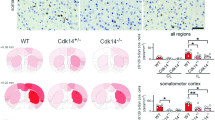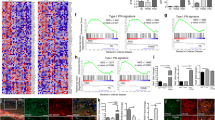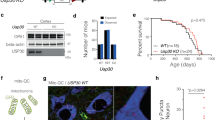Abstract
Parkinson’s disease (PD) is characterized by the selective loss of dopaminergic neurons in the substantia nigra and the accumulation of α-synuclein (α-Syn) aggregates. However, the molecular mechanisms regulating α-Syn aggregation and neuronal degeneration remain poorly understood. The peptidase M20 domain containing 1 (PM20D1) gene lies within the PARK16 locus genetically linked to PD. Single nucleotide polymorphisms regulating PM20D1 expression are associated with changed risk of PD. Dopamine (DA) metabolism and DA metabolites have been reported to regulate α-Syn pathology. Here we report that PM20D1 catalyzes the conversion of DA to N-arachidonoyl dopamine (NADA), which interacts with α-Syn and inhibits its aggregation. Simultaneously, NADA competes with α-Syn fibrils to regulate TRPV4-mediated calcium influx and downstream phosphatases, thus alleviating α-Syn phosphorylation. The expression of PM20D1 decreases during aging. Overexpression of PM20D1 or the administration of NADA in a mouse model of synucleinopathy alleviated α-Syn pathology, dopaminergic neurodegeneration, and motor impairments. These observations support the protective effect of the PM20D1-NADA pathway against the progression of α-Syn pathology in PD.

This is a preview of subscription content, access via your institution
Access options
Subscribe to this journal
Receive 12 print issues and online access
$259.00 per year
only $21.58 per issue
Buy this article
- Purchase on SpringerLink
- Instant access to full article PDF
Prices may be subject to local taxes which are calculated during checkout







Similar content being viewed by others
Data availability
The authors declare that all the data supporting the findings of this study are available within the article and its supplementary information files (‘Original uncropped membranes’ and ‘supplementary materials’).
References
Kalia LV, Lang AE. Parkinson’s disease. Lancet. 2015;386:896–912.
Tolosa E, Wenning G, Poewe W. The diagnosis of Parkinson’s disease. Lancet Neurol. 2006;5:75–86.
Blauwendraat C, Nalls MA, Singleton AB. The genetic architecture of Parkinson’s disease. Lancet Neurol. 2020;19:170–8.
Di Monte DA. The environment and Parkinson’s disease: is the nigrostriatal system preferentially targeted by neurotoxins? Lancet Neurol. 2003;2:531–8.
Hou Y, Dan X, Babbar M, Wei Y, Hasselbalch SG, Croteau DL, et al. Ageing as a risk factor for neurodegenerative disease. Nat Rev Neurol. 2019;15:565–81.
Wong YC, Krainc D. alpha-synuclein toxicity in neurodegeneration: mechanism and therapeutic strategies. Nat Med. 2017;23:1–13.
Barnham KJ, Masters CL, Bush AI. Neurodegenerative diseases and oxidative stress. Nat Rev Drug Discov. 2004;3:205–14.
Burbulla LF, Song P, Mazzulli JR, Zampese E, Wong YC, Jeon S, et al. Dopamine oxidation mediates mitochondrial and lysosomal dysfunction in Parkinson’s disease. Science. 2017;357:1255–61.
Tansey MG, Wallings RL, Houser MC, Herrick MK, Keating CE, Joers V. Inflammation and immune dysfunction in Parkinson disease. Nat Rev Immunol. 2022;22:657–73.
Spehlmann R, Stahl SM. Dopamine acetylcholine imbalance in Parkinson’s disease. Possible regenerative overgrowth of cholinergic axon terminals. Lancet. 1976;1:724–6.
Lang AE, Siderowf AD, Macklin EA, Poewe W, Brooks DJ, Fernandez HH, et al. Trial of Cinpanemab in Early Parkinson’s Disease. N Engl J Med. 2022;387:408–20.
Pagano G, Taylor KI, Anzures-Cabrera J, Marchesi M, Simuni T, Marek K, et al. Trial of Prasinezumab in Early-Stage Parkinson’s Disease. N Engl J Med. 2022;387:421–32.
Smit JW, Basile P, Prato MK, Detalle L, Mathy FX, Schmidt A, et al. Phase 1/1b Studies of UCB0599, an Oral Inhibitor of alpha-Synuclein Misfolding, Including a Randomized Study in Parkinson’s Disease. Mov Disord. 2022;37:2045–56.
Levin J, Sing N, Melbourne S, Morgan A, Mariner C, Spillantini MG, et al. Safety, tolerability and pharmacokinetics of the oligomer modulator anle138b with exposure levels sufficient for therapeutic efficacy in a murine Parkinson model: A randomised, double-blind, placebo-controlled phase 1a trial. EBioMedicine. 2022;80:104021.
Li Y, Wang T, Meng L, Jin L, Liu C, Liang Y, et al. Novel naturally occurring autoantibodies attenuate alpha-synuclein pathology in a mouse model of Parkinson’s disease. Neuropathol Appl Neurobiol. 2023;49:e12860.
Soileau MJ, Aldred J, Budur K, Fisseha N, Fung VS, Jeong A, et al. Safety and efficacy of continuous subcutaneous foslevodopa-foscarbidopa in patients with advanced Parkinson’s disease: a randomised, double-blind, active-controlled, phase 3 trial. Lancet Neurol. 2022;21:1099–109.
Soares-da-Silva P, Fernandes MH, Pinto-do-O PC. Cell inward transport of L-DOPA and 3-O-methyl-L-DOPA in rat renal tubules. Br J Pharm. 1994;112:611–5.
Burke WJ, Chung HD, Li SW. Quantitation of 3,4-dihydroxyphenylacetaldehyde and 3, 4-dihydroxyphenylglycolaldehyde, the monoamine oxidase metabolites of dopamine and noradrenaline, in human tissues by microcolumn high-performance liquid chromatography. Anal Biochem. 1999;273:111–6.
Tsunoda M, Takezawa K, Yanagisawa T, Kato M, Imai K. Determination of catecholamines and their 3-O-methyl metabolites in mouse plasma. Biomed Chromatogr. 2001;15:41–4.
Schank JR, Ventura R, Puglisi-Allegra S, Alcaro A, Cole CD, Liles LC, et al. Dopamine beta-hydroxylase knockout mice have alterations in dopamine signaling and are hypersensitive to cocaine. Neuropsychopharmacology. 2006;31:2221–30.
Itäaho K, Alakurtti S, Yli-Kauhaluoma J, Taskinen J, Coughtrie MW, Kostiainen R. Regioselective sulfonation of dopamine by SΜLT1A3 in vitro provides a molecular explanation for the preponderance of dopamine-3-O-sμlfate in human blood circulation. Biochem Pharm. 2007;74:504–10.
Uutela P, Karhu L, Piepponen P, Käenmäki M, Ketola RA, Kostiainen R. Discovery of dopamine glucuronide in rat and mouse brain microdialysis samples using liquid chromatography tandem mass spectrometry. Anal Chem. 2009;81:427–34.
Zhang Q, Chen L, Hu LJ, Liu WY, Feng F, Qu W. Two new ortho benzoquinones from Uncaria rhynchophylla. Chin J Nat Med. 2016;14:232–5.
Lindholm P, Voutilainen MH, Laurén J, Peränen J, Leppänen VM, Andressoo JO, et al. Novel neurotrophic factor CDNF protects and rescues midbrain dopamine neurons in vivo. Nature. 2007;448:73–7.
Jiang H, Song N, Xu H, Zhang S, Wang J, Xie J. Up-regulation of divalent metal transporter 1 in 6-hydroxydopamine intoxication is IRE/IRP dependent. Cell Res. 2010;20:345–56.
Masato A, Plotegher N, Boassa D, Bubacco L. Impaired dopamine metabolism in Parkinson’s disease pathogenesis. Mol Neurodegener. 2019;14:35.
Ahmadi FA, Grammatopoulos TN, Poczobutt AM, Jones SM, Snell LD, Das M, et al. Dopamine selectively sensitizes dopaminergic neurons to rotenone-induced apoptosis. Neurochem Res. 2008;33:886–901.
Masato A, Bubacco L, Greggio E. Too much for your own good: Excessive dopamine damages neurons and contributes to Parkinson’s disease: An Editorial Highlight for “Enhanced tyrosine hydroxylase activity induces oxidative stress, causes accumulation of autotoxic catecholamine metabolites, and augments amphetamine effects in vivo”. J Neurochem. 2021;158:833–6.
Werner-Allen JW, DuMond JF, Levine RL, Bax A. Toxic Dopamine Metabolite DOPAL Forms an Unexpected Dicatechol Pyrrole Adduct with Lysines of alpha-Synuclein. Angew Chem Int Ed Engl. 2016;55:7374–8.
PD Med Collaborative Group, Gray R, Ives N, Rick C, Patel S, Gray A, et al. Long-term effectiveness of dopamine agonists and monoamine oxidase B inhibitors compared with levodopa as initial treatment for Parkinson’s disease (PD MED): a large, open-label, pragmatic randomised trial. Lancet. 2014;384:1196–205.
Gray R, Patel S, Ives N, Rick C, Woolley R, Muzerengi S, et al. Long-term Effectiveness of Adjuvant Treatment With Catechol-O-Methyltransferase or Monoamine Oxidase B Inhibitors Compared With Dopamine Agonists Among Patients With Parkinson Disease Uncontrolled by Levodopa Therapy: The PD MED Randomized Clinical Trial. JAMA Neurol. 2022;79:131–40.
Sukhanova IA, Sebentsova EA, Khukhareva DD, Vysokikh MY, Bezuglov VV, Bobrov MY, et al. Early-life N-arachidonoyl-dopamine exposure increases antioxidant capacity of the brain tissues and reduces functional deficits after neonatal hypoxia in rats. Int J Dev Neurosci. 2019;78:7–18.
Kudo E, Fujii Y. Dopamine: functions, regulation, and health effects. New York: Nova Science Publishers; 2012.306.
Starowicz K, Nigam S, Di Marzo V. Biochemistry and pharmacology of endovanilloids. Pharm Ther. 2007;114:13–33.
Muller C, Morales P, Reggio PH. Cannabinoid Ligands Targeting TRP Channels. Front Mol Neurosci. 2018;11:487.
Redmond WJ, Cawston EE, Grimsey NL, Stuart J, Edington AR, Glass M, et al. Identification of N-arachidonoyl dopamine as a highly biased ligand at cannabinoid CB1 receptors. Br J Pharm. 2016;173:115–27.
Hsu CC, Bien MY, Huang YT, Ruan T, Kou YR, Lin YS. N-arachidonyl dopamine sensitizes rat capsaicin-sensitive lung vagal afferents via activation of TRPV1 receptors. Respir Physiol Neurobiol. 2009;167:323–32.
Bisogno T, Melck D, Gretskaya NM, Bezuglov VV, De Petrocellis L, Di Marzo V. N-acyl-dopamines: novel synthetic CB(1) cannabinoid-receptor ligands and inhibitors of anandamide inactivation with cannabimimetic activity in vitro and in vivo. Biochem J. 2000;351:817–24.
Novosadova E, Antonov S, Arsenyeva E, Kobylanskiy A, Vanyushina Y, Malova T, et al. Neuroprotective and neurotoxic effects of endocannabinoid-like compounds, N-arachidonoyl dopamine and N-docosahexaenoyl dopamine in differentiated cultures of induced pluripotent stem cells derived from patients with Parkinson’s disease. Neurotoxicology. 2021;82:108–18.
Novosadova EV, Arsenyeva EL, Manuilova ES, Khaspekov LG, Bobrov MY, Bezuglov VV. Neuroprotective Properties of Endocannabinoids N-Arachidonoyl Dopamine and N-Docosahexaenoyl Dopamine Examined in Neuronal Precursors Derived from Human Pluripotent Stem Cells. Biochemistry. 2017;82:1367–72.
Bobrov MY, Lizhin AA, Andrianova EL, Gretskaya NM, Frumkina LE, Khaspekov LG, et al. Antioxidant and neuroprotective properties of N-arachidonoyldopamine. Neurosci Lett. 2008;431:6–11.
Wojtalla A, Herweck F, Granzow M, Klein S, Trebicka J, Huss S, et al. The endocannabinoid N-arachidonoyl dopamine (NADA) selectively induces oxidative stress-mediated cell death in hepatic stellate cells but not in hepatocytes. Am J Physiol Gastrointest Liver Physiol. 2012;302:G873–87.
Hu SS, Bradshaw HB, Benton VM, Chen JS, Huang SM, Minassi A, et al. The biosynthesis of N-arachidonoyl dopamine (NADA), a putative endocannabinoid and endovanilloid, via conjugation of arachidonic acid with dopamine. Prostaglandins Leukot Ess Fat Acids. 2009;81:291–301.
Kim JT, Terrell SM, Li VL, Wei W, Fischer CR, Long JZ. Cooperative enzymatic control of N-acyl amino acids by PM20D1 and FAAH. Elife. 2020;9:e55211.
Long JZ, Svensson KJ, Bateman LA, Lin H, Kamenecka T, Lokurkar IA, et al. The Secreted Enzyme PM20D1 Regulates Lipidated Amino Acid Uncouplers of Mitochondria. Cell. 2016;166:424–35.
Li D, Liu Y, Gao W, Han J, Yuan R, Zhang M, et al. Inhibition of miR-324-5p increases PM20D1-mediated white and brown adipose loss and reduces body weight in juvenile mice. Eur J Pharm. 2019;863:172708.
Benson KK, Hu W, Weller AH, Bennett AH, Chen ER, Khetarpal SA, et al. PM20D1 Natural human genetic variation determines basal and inducible expression of PM20D1, an obesity-associated gene. Proc Natl Acad Sci USA. 2019;116:23232–42.
Long JZ, Roche AM, Berdan CA, Louie SM, Roberts AJ, Svensson KJ, et al. Ablation of PM20D1 reveals N-acyl amino acid control of metabolism and nociception. Proc Natl Acad Sci USA. 2018;115:E6937–E6945.
Song N, Fang Y, Zhu H, Liu J, Jiang S, Sun S, et al. Kir6.2 is essential to maintain neurite features by modulating PM20D1-reduced mitochondrial ATP generation. Redox Biol. 2021;47:102168.
Wang W, Meng X, Yang C, Fang D, Wang X, An J, et al. Brown adipose tissue activation in a rat model of Parkinson’s disease. Am J Physiol Endocrinol Metab. 2017;313:E731–E736.
Larrick JW, Larrick JW, Mendelsohn AR. Uncoupling Mitochondrial Respiration for Diabesity. Rejuvenation Res. 2016;19:337–40.
Satake W, Nakabayashi Y, Mizuta I, Hirota Y, Ito C, Kubo M, et al. Genome-wide association study identifies common variants at four loci as genetic risk factors for Parkinson’s disease. Nat Genet. 2009;41:1303–7.
Cibulka M, Brodnanova M, Grendar M, Necpal J, Benetin J, Han V, et al. Alzheimer’s Disease-Associated SNP rs708727 in SLC41A1 May Increase Risk for Parkinson’s Disease: Report from Enlarged Slovak Study. Int J Mol Sci. 2022;23:1604.
Sanchez-Mut JV, Glauser L, Monk D, Gräff J. Comprehensive analysis of PM20D1 QTL in Alzheimer’s disease. Clin Epigenetics. 2020;12:20.
Rudakou U, Yu E, Krohn L, Ruskey JA, Asayesh F, Dauvilliers Y, et al. Targeted sequencing of Parkinson’s disease loci genes highlights SYT11, FGF20 and other associations. Brain. 2021;144:462–72.
Paul KC, Kusters C, Furlong M, Zhang K, Yu Y, Folle AD, et al. Immune system disruptions implicated in whole blood epigenome-wide association study of depression among Parkinson’s disease patients. Brain Behav Immun Health. 2022;26:100530.
Sanchez-Mut JV, Heyn H, Silva BA, Dixsaut L, Garcia-Esparcia P, Vidal E, et al. PM20D1 is a quantitative trait locus associated with Alzheimer’s disease. Nat Med. 2018;24:598–603.
Fauvet B, Mbefo MK, Fares MB, Desobry C, Michael S, Ardah MT, et al. alpha-Synuclein in central nervous system and from erythrocytes, mammalian cells, and Escherichia coli exists predominantly as disordered monomer. J Biol Chem. 2012;287:15345–64.
John R. Crowther, Methods in Molecular Biology, the ELISA Guidebook, 2nd ed. Humana Press, a part of Springer Science + Business Media, LLC 2009.
Butler JE. The Behavior of Antigens and Antibodies Immobilized on a Solid Phase. In: Van Regenmortel MHV, editor. Structure of Antigens. Boca Raton, FL: CRC Press, 1992. 209-59. Vol. 1.
Lequin RM. Enzyme immunoassay (EIA)/enzyme-linked immunosorbent assay (ELISA). Clin Chem. 2005;51:2415–8.
Sliter DA, Martinez J, Hao L, Chen X, Sun N, Fischer TD, et al. Parkin and PINK1 mitigate STING-induced inflammation. Nature. 2018;561:258–62.
Casarotto PC, Girych M, Fred SM, Kovaleva V, Moliner R, Enkavi G, et al. Antidepressant drugs act by directly binding to TRKB neurotrophin receptors. Cell. 2021;184:1299–.e19.
Balvers MG, Verhoeckx KC, Witkamp RF. Development and validation of a quantitative method for the determination of 12 endocannabinoids and related compounds in human plasma using liquid chromatography-tandem mass spectrometry. J Chromatogr B Anal Technol Biomed Life Sci. 2009;877:1583–90.
Huang SM, Bisogno T, Trevisani M, Al-Hayani A, De Petrocellis L, Fezza F, et al. An endogenous capsaicin-like substance with high potency at recombinant and native vanilloid VR1 receptors. Proc Natl Acad Sci USA. 2002;99:8400–5.
Zajac D, Matysiak Z, Czarnocki Z, Pokorski M, et al. Membrane association of N-oleoyl-dopamine in rat brain. J Physiol Pharm. 2006;57:403–8.
Butler YR, Liu Y, Kumbhar R, Zhao P, Gadhave K, Wang N, et al. alpha-Synuclein fibril-specific nanobody reduces prion-like alpha-synuclein spreading in mice. Nat Commun. 2022;13:4060.
Bieri G, Brahic M, Bousset L, Couthouis J, Kramer NJ, Ma R, et al. LRRK2 modifies alpha-syn pathology and spread in mouse models and human neurons. Acta Neuropathol. 2019;137:961–80.
Bera K, Kiepas A, Godet I, Li Y, Mehta P, Ifemembi B, et al. Extracellular fluid viscosity enhances cell migration and cancer disSDination. Nature. 2022;611:365–73.
Serrat R, Covelo A, Kouskoff V, Delcasso S, Ruiz-Calvo A, Chenouard N, et al. Astroglial ER-mitochondria calcium transfer mediates endocannabinoid-dependent synaptic integration. Cell Rep. 2021;37:110133.
Ito N, Ruegg UT, Kudo A, Miyagoe-Suzuki Y, Takeda S. Activation of calcium signaling through Trpv1 by nNOS and peroxynitrite as a key trigger of skeletal muscle hypertrophy. Nat Med. 2013;19:101–6.
Lai H, Liu C, Hou L, Lin W, Chen T, Hong A. TRPM8-regμlated calcium mobilization plays a critical role in synergistic chemosensitization of Borneol on Doxorubicin. Theranostics. 2020;10:10154–70.
Takahashi M, Uchikado H, Caprotti D, Weidenheim KM, Dickson DW, Ksiezak-Reding H, et al. Identification of G-protein coupled receptor kinase 2 in paired helical filaments and neurofibrillary tangles. J Neuropathol Exp Neurol. 2006;65:1157–69.
Shin WH, Chung KC. Death-associated Protein Kinase 1 Phosphorylates alpha-Synuclein at Ser129 and Exacerbates Rotenone-induced Toxic Aggregation of alpha-Synuclein in Dopaminergic SH-SY5Y Cells. Exp Neurobiol. 2020;29:207–18.
Yuan YH, Yan WF, Sun JD, Huang JY, Mu Z, Chen NH. The molecular mechanism of rotenone-induced alpha-synuclein aggregation: emphasizing the role of the calcium/GSK3beta pathway. Toxicol Lett. 2015;233:163–71.
White JP, Cibelli M, Urban L, Nilius B, McGeown JG, Nagy I. TRPV4: Molecular Conductor of a Diverse Orchestra. Physiol Rev. 2016;96:911–73.
Fujiwara H, Hasegawa M, Dohmae N, Kawashima A, Masliah E, Goldberg MS, et al. alpha-Synuclein is phosphorylated in synucleinopathy lesions. Nat Cell Biol. 2002;4:160–4.
You H, Mariani LL, Mangone G, Le Febvre de Nailly D, Charbonnier-Beaupel F, Corvol JC. Molecular basis of dopamine replacement therapy and its side effects in Parkinson’s disease. Cell Tissue Res. 2018;373:111–35.
Friedman JH. Early- vs late-start levodopa relieved symptoms but did not affect disease progression in Parkinson disease. Ann Intern Med. 2019;170:JC56.
Verschuur CVM, Suwijn SR, Boel JA, Post B, Bloem BR, van Hilten JJ, et al. Randomized Delayed-Start Trial of Levodopa in Parkinson’s Disease. N Engl J Med. 2019;380:315–24.
Yamamoto BK, Novotney S. Regulation of extracellular dopamine by the norepinephrine transporter. J Neurochem. 1998;71:274–80.
Morón JA, Brockington A, Wise RA, Rocha BA, Hope BT. Dopamine uptake through the norepinephrine transporter in brain regions with low levels of the dopamine transporter: evidence from knock-out mouse lines. J Neurosci. 2002;22:389–95.
Strauss M, O’Donovan B, Ma Y, Xiao Z, Lin S, Bardo MT, et al. [3H]Dopamine Uptake through the Dopamine and Norepinephrine Transporters is Decreased in the Prefrontal Cortex of Transgenic Mice Expressing HIV-1 Transactivator of Transcription Protein. J Pharmacol Exp Ther. 2020;374:241–51.
Clauss NJ, Mayer FP, Owens WA, Vitela M, Clarke KM, Bowman MA, et al. Ethanol inhibits dopamine uptake via organic cation transporter 3: Implications for ethanol and cocaine co-abuse. Mol Psychiatry. 2023;28:2934–45.
Pihlstrøm L, Rengmark A, Bjørnarå KA, Dizdar N, Fardell C, Forsgren L, et al. Fine mapping and resequencing of the PARK16 locus in Parkinson’s disease. J Hum Genet. 2015;60:357–62.
Choi ML, Chappard A, Singh BP, Maclachlan C, Rodrigues M, Fedotova EI, et al. Pathological structural conversion of alpha-synuclein at the mitochondria induces neuronal toxicity. Nat Neurosci. 2022;25:1134–48.
Park Jae-Hyeon, Burgess JeremyD, Faroqi AymanH, DeMeo NatashaN, Fiesel FabienneC, Springer Wolfdieter, et al. Alpha-synuclein-induced mitochondrial dysfunction is mediated via a sirtuin 3-dependent pathway. Mol Neurodegener. 2020;15:5.
Acknowledgements
This work was supported by grants from the National Natural Science Foundation of China (No. 82271447, 81771382, China), the National Key Research and Development Program of China (2019YFE0115900, China), the Innovative Research Groups of Hubei Province (2022CFA026, China), and the ‘New 20 Terms of Universities in Jinan’ grant (No. 202228022).
Author information
Authors and Affiliations
Contributions
Professor Zhentao Zhang performed conceptualization and funding acquisition, provided supervision and managed the project; Dr. Yunying Yang, Li Zhang and Sichun Chen designed and conducted the experiments and wrote the paper; Dr. Sichun Chen, Professor Hua Hou, Dr. Guoxin Zhang, Yan Liu, Yiming Li, Li Zou, Ye Tian, Lijun Dai, Min Xiong and Lina Pan contributed to the development of the methodology, data curation and visualization; Professor Lanxia Meng, Jing Xiong, Liam Chen and Zhui Yu performed the data analysis, manuscript review and editing.
Corresponding author
Ethics declarations
Competing interests
The authors declare no competing interests.
Ethics
All animal experiments were ethically approved by the Institutional Animal Care and Use Committee (IACUC) of Renmin Hospital of Wuhan University (Approval No. 20210712).
Additional information
Publisher’s note Springer Nature remains neutral with regard to jurisdictional claims in published maps and institutional affiliations.
Supplementary information
Rights and permissions
Springer Nature or its licensor (e.g. a society or other partner) holds exclusive rights to this article under a publishing agreement with the author(s) or other rightsholder(s); author self-archiving of the accepted manuscript version of this article is solely governed by the terms of such publishing agreement and applicable law.
About this article
Cite this article
Yang, Y., Chen, S., Zhang, L. et al. The PM20D1-NADA pathway protects against Parkinson’s disease. Cell Death Differ (2024). https://doi.org/10.1038/s41418-024-01356-9
Received:
Revised:
Accepted:
Published:
DOI: https://doi.org/10.1038/s41418-024-01356-9



